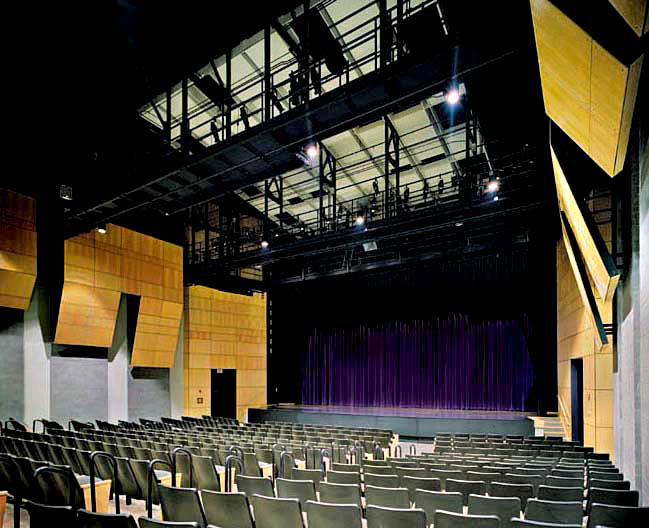
Home · Email · List of Projects · Project Sites and Links · Articles · Robert Davis Biography
Roberts Wesleyan College - Rochester, New York

The Cultural Life Center at Roberts Wesleyan College includes the 1000-seat Andrews B. Hale Auditorium and the Robert Shewan Recital Hall.
The auditorium is used primarily for music, especially choral music, as well as for theatrical programs and events for the spoken word.
The stage is equipped with a full proscenium fly tower, stage rigging, orchestra shell, the most modern dimming and control technology, and over 200 stage lighting fixtures. It can accommodate most major performing arts touring companies including dance, ballet, drama, and opera.
Acoustical features of the auditorium include:
- A classic shoebox shape. The room is exceptionally long and high, which is ideal for this kind of music.
- A concert enclosure that retracts to expose a theatrical stagehouse. The enclosure surfaces are optimized for good hearing among ensemble members and to project sound into the auditorium.
- An adjustable forestage acoustical canopy. The canopy is designed to reflect performance sound into the audience for improved intelligibility, and to adjust the balance of early-to-late reflections between speech and music performances through shutters that can open and close portions of the canopy. The canopy adapts the room for different acoustical styles. Motor operated sliding shutters cover the openings in the canopy. This directs acoustical energy downward where it is heard and absorbed quickly, rather than upward where the energy would persist and be heard and absorbed later. The panels can be set anywhere from full open to full closed, allowing continuous gradations of adjustment.
- Side wall panels that provide lateral reflections. Lateral reflections enhance the binaural aspect of the experience, increase the apparent acoustical width of the performance, and add "presence".
- A computer-optimized central loudspeaker cluster that directs sound uniformly into the audience areas but not onto the walls. This reduces interference effects and enhances the clarity of voice reinforcement.
- Rear wall acoustical draperies that adjust reverberation and reduce echo.

Robert Shewan Recital Hall
The recital hall provides excellent acoustics for choral and instrumental classes, for rehearsals, and for intimate musical performances.The large volume of this hall (106,000 cubic feet) avoids excessive loudness and provides appropriate reverberation. The combination of an overhead canopy and the very high ceiling provides mixing and early reflections, allowing individual performers to hear themselves, hear other individuals, and hear other sections of the ensemble. Performers hearing other performers is important in all music rooms, but is especially important for student musicians in rehearsal.
Vertical sound diffusing elements on the overhead canopy and diffusion by an array of sound absorbent wall panels further optimizes the hearing environment.
Daylight is provided. Daylight and exterior views were valued as an important element in a good classroom environment, and they enhance recitals.
Mechanical noise control relied on accurate early strategic planning
Control of air noise and machine noise was planned from the start to provide critically needed low mechanical noise levels. The auditorium was designed for RC-20 and the recital hall for RC-25. To achieve these goals economically each element of the air handling system was selected to be quiet and was remotely located. Based on each space's room criterion, air ducts were sized and acoustically lined to attenuate fan noise and not cause turbulence noise. The planning of economical acoustical isolation was the longest critical path in the design timeline and involved every member of the design team.Architect: SWBR Architects of Rochester
Acoustician: Kring Herbert of Ostergaard Acoustical Associates
Home · List of Projects